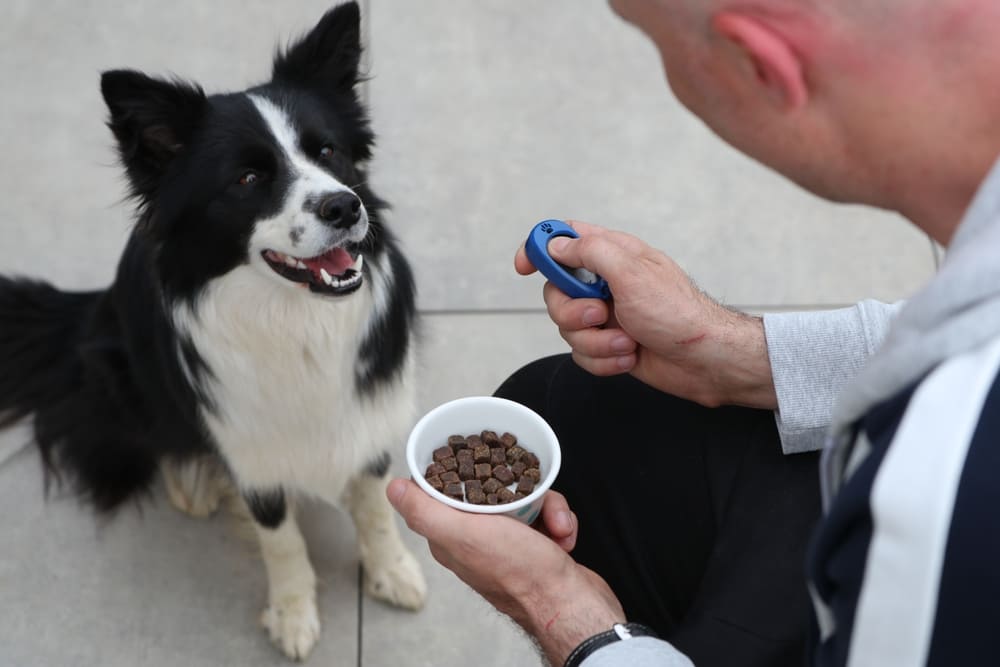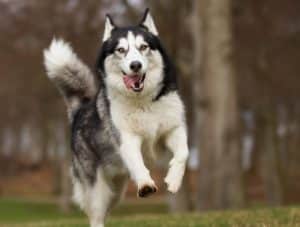Positive reinforcement is a training method in which you reward your dog for desired behavior. Thus, he will be more inclined to reproduce this behavior.
Here’s a comprehensive breakdown of positive reinforcement dog training, with key takeaways:
What is Positive Reinforcement?
- Focus on the Good: Reward the behaviors you want to see more of (sit, stay, calm greeting).
- Treats, Praise, Play: Use whatever your dog loves as a reward!
- Kind and Effective: Builds a trusting relationship with your dog while making learning fun.
Why Use Positive Reinforcement?
- Builds a Strong Bond: Your dog sees you as a source of good things, making them eager to please.
- Boosts Confidence: Success feels great! Rewarded dogs learn they can do it, making them try harder.
- Faster Learning: Dogs learn best when they understand what is expected and feel motivated.
- Less Stress for Everyone: A positive environment makes learning relaxed and fun for both you and your dog.
Getting Started with Positive Reinforcement
- Choose the Right Treats: Small, yummy, and easy to eat quickly. Experiment to find your dog’s favorites.
- Timing is Key: Reward the exact moment they do the right thing. If you’re too slow, they won’t connect the treat to the desired behavior.
- Keep Sessions Short and Sweet: Especially for puppies! Several 5-10 minute sessions a day are best.
- Be Patient and Consistent: Learning takes time. Stick with it, and your dog will catch on!
Key Takeaways
- Positive Reinforcement is for Everyone: It works with any dog, regardless of age, breed, or temperament.
- Success is About Rewarding What You Want: Focus on catching your dog doing the right things, and those behaviors will become habits.
- It Creates Happy, Confident Dogs: Positive training is a win-win – your dog is well-behaved while having a great time!
Ready to Give it a Try? Let’s Work on “Sit”
- Hold a treat in front of your dog’s nose.
- Slowly move the treat up and over their head. As their nose follows, their butt should naturally go down.
- The instant their butt hits the floor, say “YES!” and give the treat.
- Repeat! If they get up, start again. It might take a few tries.
What Is Positive Reinforcement For Dogs?
Although many methods today make it possible to train a dog while respecting the animal, positive reinforcement is not always well applied by the owner who discovers this technique.
What exactly is positive reinforcement for dogs? Should we let the animal act as it wishes and never punish it? What education is positive reinforcement based on and what are the advantages of the reward system?
How to properly work on positive reinforcement for your dog and avoid mistakes? Let’s come back to this technique which has nothing to do with laxity, and indeed allows us to educate the dog.
While many dog owners call on a dog trainer to socialize their dogs, others invest in providing consistent, constant, and non-coercive training to teach their dogs to be obedient.
Positive education is today the most recommended approach to making your four-legged companion a balanced and docile doggie.
However, it is based on concepts that are sometimes poorly understood: positive reinforcement, negative reinforcement, but also positive or negative punishment.
This is based on the alliance between positive reinforcement and negative punishment to favor consistency in the conditioning of the animal. Applying only positive reinforcement is not enough to educate the dog, who must also understand the advantages of avoiding punishment for him.
Importance Of Positive Reinforcement Training:
You may be wondering why you choose positive reinforcement over other methods. Here are some good reasons:
A Stronger Bond With Your Dog:
By using positive reinforcement, you encourage your dog to behave well without resorting to punishment. He will see you as a source of good things and will develop a stronger bond with you.
Improve Your Dog’s Confidence:
By receiving rewards for good behavior, your dog gains confidence and self-assurance. He knows he is doing things well and is proud of himself.
Faster Learning:
Dogs learn faster and more effectively when their good behaviors are positively reinforced. Reward is a powerful motivator for your dog.
A More Serene Living Environment:
By practicing positive reinforcement, you contribute to a favorable and pleasant climate for your dog. He will thus be more relaxed, at ease and less exposed to stressful or anxious situations.
At What Age Can You Train Your Dog?
It is recommended to start dog training as soon as possible. Puppies can begin training as early as eight weeks old, focusing primarily on socialization and basic obedience.
However, it is never too late to train a dog. Even adult dogs can benefit from dog training to correct unwanted behaviors or reinforce existing skills.
The trainer can also work on adult or even senior dogs who have complicated behaviors following trauma. If you adopt an animal from a shelter and it is very fearful or aggressive, its age should in no case be a barrier to consulting an educator, quite the contrary. You will act for his well-being, even if the sessions may be more numerous than for a puppy.
A dog training session is an important step in establishing a healthy and harmonious relationship with your dog. By working with a professional dog trainer, you can learn proper techniques, address behavioral issues, and strengthen the connection with your four-legged companion.
Remember that dog training requires time, patience, and consistency, but the results are worth it for a life full of happiness and bonding with your dog.
Positive Or Negative Reinforcement, What Are The Differences?
Positive reinforcement aims to encourage and encourage the behaviors you expect from your dog by providing a reward or pleasant stimulus. The animal thus cooperates with your request by repeating and rewarding iteratively.
The stimulus will depend on the animal’s appetite for treats, games, or cuddles. We will rely or not on the clicker, whose noise, like Pavlov’s dog, will be associated with the reward.
Conversely, negative reinforcement relies on coercion through chokes or electric collars, and verbal or physical sanctions to encourage doggies to adopt the expected behavior.
Using an aversive stimulus forces your four-legged friend to obey through avoidance. We remove the latter when he stops shooting, running away, and jumping on people.
Practical Tips For Positive Reinforcement:
When you enter the world of dog training, you quickly realize that dog-training treats become your most valuable allies.
These little delights are not only tasty rewards, but they play an essential role in the training process of your four-legged friend. In this in-depth exploration of training treats, let’s dive into why they’re so effective, how to choose them wisely, and how to use them to encourage desired behavior in your pet.
Selecting the Best Treats for your Dog:
When it comes to rewarding your faithful companion during training or learning new skills, choosing the right type and quantity of treats is crucial to their health and well-being. Quality dog food is essential, even when it comes to rewards.
Always opt for quality, natural treats, preferably protein-rich treats, which you can find at a reputable natural treat store.
These alternatives to industrial treats are not only healthier, but they also avoid the artificial ingredients and unnecessary additives often found in the treat market. Consider your dog’s long-term health while motivating him with tasty rewards during education and training sessions.
Motivational Bites:
Dog training rewards are more than just treats. They are valuable incentives to reinforce good behavior and guide the dog in its positive education.
When your companion correctly responds to a command or performs a desired action, training treats, such as pieces of tender meat or appetizing kibble, immediately reward this accomplishment. This association between action and reward allows your companion to quickly understand what is expected of him when learning techniques.
It is advisable to use different types of natural treats, tailored to your dog’s size and preferences, to maintain interest and motivation throughout the training session.
Choosing the Right Treats:
Choosing the appropriate training treats is crucial to maintaining the dog’s interest and motivation during dog training. Opt for a treat that is small, easy to chew, and swallow quickly when selecting treats for dog training and rewards.
Too large bites could distract your pet during positive education sessions. Additionally, choose treats with a tempting smell, as the sense of smell plays a vital role in your companion’s positive response to learning new knowledge and techniques.
Uses Varied Rewards:
Treats aren’t the only possible rewards. Toys, petting, and verbal praise are also effective positive reinforcers. Vary the rewards to keep your dog interested and prevent him from getting bored.
Start With Short Workouts:
Training periods should be short and enjoyable for your four-legged friend. Opt for several sessions of 5 to 10 minutes scattered throughout the day, rather than a single longer session. This keeps your dog interested and prevents boredom.
Be Patient:
Acquiring skills takes time. It is therefore crucial not to lose hope if your faithful friend does not evolve as quickly as you would like. Persistence and tolerance are the key elements to success. If you are consistent in your approach and continue to positively reinforce the desired behaviors, your dog will eventually internalize them.
Stay Positive:
You must keep a positive attitude and support your dog throughout his learning. Even if your dog doesn’t always follow instructions to the letter, refrain from expressing frustration or irritation.
Don’t Forget The Importance Of Timing:
The timing of rewarding your dog is crucial to reinforcing good behavior. Make sure to give the reward immediately after the desired behavior. If you wait too long, your dog may not make the connection between his behavior and the reward.
“Understanding the nuances of effective training techniques is essential for any learning process, be it for humans or animals. In the realm of pet care, Dog training particularly vital as it not only shapes obedient behaviour but also fosters a bond between the pet and its owner. Programs like those offered at Brain Training for Dogs provide in-depth insights and practical approaches to dog training. Their methodologies emphasize mental stimulation that goes beyond the basics, ensuring a well-trained and mentally agile pet.”
The Benefits Of The Positive Reinforcement Reward System For Educating Your Dog:
The benefits of positive reinforcement and the reward system in dogs are numerous. The stimulus method linked to reward demonstrates numerous advantages for the dog and for its owner.
Behavior Reinforcement:
Treats are instant rewards that positively reinforce desired behavior. Your dog quickly associates his actions with delicious bites, making training easier.
Motivation:
The importance of treats in motivating your dog to cooperate and learn. The anticipation of the reward causes him to focus on your instructions.
Communication:
The treat facilitates communication between you and your dog. They create a bond of understanding and reinforce the signals you send.
Protect Your Dog From The Hazards Of Life:
Your dog is part of the family and, as such, you want to guarantee him the best care possible. Whether for small or major health concerns, taking out dog health insurance is ideal. You will thus be able to meet all the necessary expenses in the event of a hard hit. Carrefour Assurance offers dog and cat health insurance suitable for all budgets.
Well-Being:
The first and main benefit of this method of training your dog is psychological well-being. Indeed, the traditional method, based on domination and fear, stresses the animal.
He is anxious and stressed, which does not encourage his brain to work on what you are asking of him. He simply acts to avoid being scolded, and his learning is then more of a “survival” tactic than a desire to work with you and have fun doing it.
By adopting a positive way to educate him, your dog is not anxious, he is happy to please you, and feels good: the person he trusts the most does not risk turning into a master brutal and angry.
Close Relationship With Their Animals:
In addition, your dog will place unfailing trust in you, and will therefore be much more capable of doing everything you ask of him.
Owners who use positive education are often in a close relationship with their animals because their mutual understanding is much stronger than in master/dog couples who use the principle of submission.
These are duos that work very well in dog sports such as canicross or flyball. In short, positive education is the secret to living well with your dog.
By choosing cooperation rather than coercion, the animal is more obedient and more fulfilled. Above all, aggressive behavior triggered by physical punishment and the trauma it can cause in the animal is absent.
Positive punishment remains one of the common factors of aggression in abused dogs. By choosing kindness, a bond of trust is established between the dog and its master. Your pooch will even show enthusiasm about learning new commands or tricks.
However, caresses, praise and games are often insufficient to motivate doggies to please us. Numerous studies show that the dog will be more inclined to carry out a command if the key is a treat. Also pay attention to the value of the treat,
if your canine friend seems to shy away from it, it may simply be because he doesn’t like it. Finally, patience is a virtue that must be preserved for each learning process and some children will be much slower in mastering basic commands.
How To Work On Positive Reinforcement With Your Dog?
Positive dog training is an approach based on positive reinforcement and mutual respect between the owner and their pet. It is based on caring methods that promote learning, cooperation, and the reinforcement of desirable behaviors in dogs.
The Reward Must Please Your Dog Above All:
Timing, choice of rewards, and frequencies are all points to take into account when working on positive reinforcement with your dog.
Even if our doggies are known to be less picky than cats, the choice of a biscuit versus a piece of ham is very important. And if your dog is more eager for praise and petting, treats may not have as much effect as “very good!” playful. Observe him, and test different rewards to make sure what he prefers.
Timing: Before The Hour Is Not The Hour But After The Hour Either:
One of the main difficulties with positive reinforcement is giving rewards at the right time. If you give your dog the command to sit and slip him the reward when he has just gotten back up, he will not associate it with this command. This must therefore be given within the second your dog has performed the action you wish to reinforce.
The Frequency Of Rewards At The Start Of Learning:
The world is cruel, your delicious little piece of sausage can turn out to be very bland compared to the wonderful fragrance of a hedgehog or a hare.
Distractions such as sounds, smells, and the sight of a friend are unfair competition for the rewards you offer him. Make sure to keep your dog’s concentration intact by offering treats often as he takes his first steps outside the house and garden.
As part of learning to walk on a leash, prevent your dog from getting into the habit of pulling you like a common weight.
Avoid Confusion In Dogs:
If you want to practice the “no move” command, your dog mustn’t move a bit to receive his treat. For remote work, you will need to toss the treat or use a remote dispensing device.
For orders, a word corresponds to a single command, and above all we avoid terms and expressions with similar sounds so that your dog understands what you expect from him.
We Respect The Stages Of Learning:
There’s no point teaching your dog to stay focused outside, in a noisy, lively environment if he can’t yet do it in your house and garden. Always start by teaching him a new command at home. If you don’t have a garden, choose a quiet place at a time when few distractions will disrupt his learning.
Be Fun And Enthusiastic:
Each training session should be short, fun, and positive. To help your dog behave well and enjoy learning new things, the time should be short and adapted to the age of your pet. The exercise must always end in a good mood to make your dog want to do it again.
Stay Consistent:
If something is forbidden, it must be forbidden all the time and all members of the household must impose the same rules on it.
Keep It Simple:
A single word, a group of words at most, but a complete sentence will not help him understand your request. A brief, cheerful “sit” is better than a “Would you please sit down?”
The reward should always be given immediately after the dog obeys. Your pet lives in the moment, so he risks associating the reward with a completely different action than the one for which you praised him if you wait too long.
The Reward Must Be Deserved:
Giving a treat to your pet because he asks for it or because you feel the desire to spoil him, cancels out the efforts in learning. Why on earth would your pooch force himself to learn this new trick if he can get a treat just by making eyes at you?
Forgetting To Crop Your Dog:
When your dog begins to adopt an inappropriate attitude, this behavior must be corrected. Positive reinforcement requires a real investment on the part of the owner at the start and it is not always easy to embark on the adventure alone.
If you fear that the positive reinforcement method is difficult to implement, seek advice from a dog trainer. He will be able to guide you in your puppy’s first learning or help you restore trust with your doggie to educate or re-educate him.
Avoid Overstimulation:
If your dog is too excited or distracted, he will have difficulty focusing on the behavior you want to encourage. Choose quiet times to train him, away from distractions.
Don’t Overdo Treats:
Although treats are powerful positive reinforcers, don’t overdo them. Your dog may gain weight or become dependent on treats to behave properly.
Conclusion:
Early training of puppies is an investment in their future well-being and in the quality of the relationship they have with their owners. By starting early, you lay the foundation for a harmonious and balanced life for your canine companion. Investing in quality training from a young age translates into years of joy and bonding with your dog.
FAQ:
What are the best training treats for my dog?
There is no single answer. Opt for natural and small treats, rich in aromas and flavors. Choose those that suit your dog’s dietary needs and motivate him.
How can I prevent my dog from gaining excessive weight with training treats?
Moderation is key. Use small treats and incorporate them into their daily diet by slightly reducing meal portions.
Are training treats suitable for all dogs?
Yes, but consider your dog’s food allergies and preferences. If necessary, consult your veterinarian for specific recommendations.
How often can I use training treats?
Use them primarily during training sessions to reinforce desired behaviors. It is advisable to vary the types of rewards to avoid fatigue.
Can training treats be used for all types of training?
Training treats are versatile and can be used for various learning, whether teaching basic commands, correcting unwanted behaviors, or reinforcing advanced skills. However, some training sessions may require other types of rewards specific to the situation.
How can I prevent my dog from becoming too dependent on treats?
To prevent your dog from becoming too dependent on treats to obey, it is important to vary the types of rewards. Alternate between verbal praise, petting, and toys in addition to treats. Gradually decrease the frequency of treats as your dog masters the desired behaviors.
“Understanding the nuances of effective training techniques is essential for any learning process, be it for humans or animals. In the realm of pet care, Dog Training (Course) is particularly vital as it not only shapes obedient behavior but also fosters a bond between the pet and its owner. It offers an extensive course that is cost-effective, with the entire course priced at just the equivalent of what a dog trainer might charge for a single hour ($40 to $120). It covers a wide array of behaviours including Potty Training, Lunging, Jumping, Digging, Whining, Chewing, Excessive Barking, Impulse Control, Hyperactivity, Ignoring Commands, and much more. Plus, they provide a 100% money-back guarantee if you cancel within 60 days, ensuring that your investment is risk-free.”








